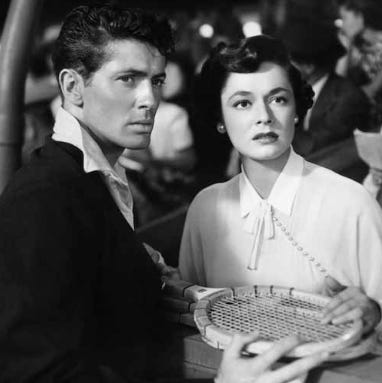Is this Train Heading to the American Dream?
It’s the best murder set-up in all of crime fiction: the murder exchange between strangers. Film rights for Strangers on a Train, Patricia Highsmith’s 1950 debut novel, sold to Alfred Hitchcock for just $7500 because he concealed his name during the negotiations. When Highsmith found out she was furious. Hitchcock’s Strangers on a Train modifies Highsmith’s characters and setting, encoding, whether he meant to or not, a version of the rags-to-riches story so crucial to the myth of a US meritocracy.
Since then the story has been redone as a black comedy, Throw Momma from the Train, and is on Netflix in a teen adaptation, Do Revenge. Now there’s news of a new version in development at Netflix with Gillian Flynn writing the script. David Fincher, director of Gone Girl and Fight Club, will direct with Ben Affleck starring. The murder exchange meeting will take place on a plane – inevitable as the US rail system is a decrepit vestige. It will be fascinating to see what Flynn does with this plot structure.
Strangers on a Train has been analyzed from angles galore. There’s the motif of the doppelganger, the double or evil twin. This view sees Bruno Antony, the sociopathic rich guy in the film who wants his dad murdered so he can inherit, as an embodiment of the repressed impulses of mild-mannered Guy Haines, the attractive tennis star who hopes to marry a senator’s daughter if he can divorce his first wife.
Others find intimations of homosexuality between the two men, shown when Bruno is stalking Guy after he’s murdered Guy’s wife. Or the provocation of their first conversation by an accidental kick followed by Bruno’s obsession with his hands’ ability to strangle leads to explorations of fetishism. The black-and-white lighting contrasts point to noir, Bruno’s madness evokes surrealism and on and on.
Highsmith’s duo in her novel includes an architect who wants to marry a new love and a wealthy momma’s boy who resents his stepfather. When Hitchcock replaced the architect with a tennis star hoping to enter politics the symbolism of the story enlarged. Now in addition to telling a murder thriller, it’s a story of class and wealth in America. It’s another rags-to-riches story, like those by Horatio Alger, that justifies the American dream.
Guy Haines, an athletic attractive man from working class origins, aspires to get into politics, a goal which will be made much more feasible by marrying a senator’s daughter. She’s madly in love with him and the senator is on board, but Guy would have to get rid of his uncouth working class wife, Miriam. There’s no explanation of what brought Guy and Miriam together in the first place or what she was supposed to do while he traveled the tennis circuit working his way up to Wimbledon and ingratiating himself with a senator’s family.
Social climbing by trading up wives is justified by making Miriam promiscuous and avaricious. She’s portrayed as morally repugnant for stepping out of the marriage but Guy is not. She refuses money for a divorce lawyer because she calculates she can get more by maintaining her claim on hubby. She’s supposedly pregnant by somebody else and goes with two guys to the carnival suggesting sexual perversion. Her immorality justifies her murder while Guy remains morally pure because he didn’t really want Bruno to go through with the murder. Still, he benefits.
This murder story reveals the underbelly of the quintessential American rags-to-riches story. Usually it’s a tale of a gifted poor boy who works hard, stays ethical and ultimately gains wealth and power. In Hitchcock’s hands that talented poor boy must literally murder his working class spouse to get ahead and the inherited wealth class helps him do it.
In Highsmith’s novel, after the spoiled rich guy murders the architect’s wife, the architect kills the rich guy’s stepfather completing the pact. But he feels guilty, confesses and ends up going to jail so morality is vindicated. Highsmith, a sort of feminist-misogynist, makes the gender aspect of her plot explicit. After the architect confesses his crime to Miriam’s former lover, this man displays no concern for Miriam’s death and reveals he never loved her. He dismisses women in general as the two men drink together.
Viewers of Strangers on the Train think they’re watching a thriller where the suspense-generating question is: will the good guy get unjustly arrested for the murder of his wife? Understanding the encoding of a rags-to-riches myth that exposes the necessary element of femicide, the question becomes: does class-climbing in America require elimination of those considered unworthy? And should we care? I’d love to hear what you think!











